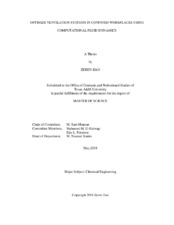| dc.contributor.advisor | Mannan, Sam | |
| dc.creator | Jiao, Zeren | |
| dc.date.accessioned | 2019-01-17T17:45:47Z | |
| dc.date.available | 2019-01-17T17:45:47Z | |
| dc.date.created | 2018-05 | |
| dc.date.issued | 2018-04-30 | |
| dc.date.submitted | May 2018 | |
| dc.identifier.uri | https://hdl.handle.net/1969.1/173448 | |
| dc.description.abstract | Chemical industry and society always want to eliminate the damage to the environment and lower the casualty if an incident occurs. Finding a more efficient and effective way to achieve this goal is now more critical than ever. The ventilation system is the most common engineering method to control the airborne toxic and explosive material in confined workplaces. The purpose of ventilation is to dilute or remove the toxic and explosive vapors with air to prevent potential poisoning or explosion.
Optimized ventilation system design is critical to industrial hygiene control and to improve ventilation system efficiency. Insufficient ventilation can directly threaten the worker’s health and life. A properly designed industrial ventilation system can significantly improve the safety of workplaces and maintain a comfortable work condition. Ventilation can also prevent the corrosion and increase the life of process units and equipment. Newly designed chemical facilities should make sure that proper ventilation systems are used to control air quality, and plants already in operation should also carefully evaluate the work environment to ensure compliance with the federal codes and regulations.
Computational Fluid Dynamics has been used in this thesis to analyze the fluid dynamics performance in the laboratory environment using the dilution ventilation system. A variety of different ventilation system installation schemes are proposed, and the performance of different schemes is examined and compared through simulation to get the optimal installation plan for the best contaminant control.
The proposed scheme also optimizes the ventilating system installation by investigating the system’s performance with different transmitted mediums. The results of this work can serve as references to maximize the ventilation efficiency and minimize the energy cost. | en |
| dc.format.mimetype | application/pdf | |
| dc.language.iso | en | |
| dc.subject | Ventilation | en |
| dc.subject | Computational Fluid Dynamics | en |
| dc.subject | Process Safety | en |
| dc.title | Optimize Ventilation Systems in Confined Workplaces Using Computational Fluid Dynamics | en |
| dc.type | Thesis | en |
| thesis.degree.department | Chemical Engineering | en |
| thesis.degree.discipline | Chemical Engineering | en |
| thesis.degree.grantor | Texas A & M University | en |
| thesis.degree.name | Master of Science | en |
| thesis.degree.level | Masters | en |
| dc.contributor.committeeMember | Peterson, Eric | |
| dc.contributor.committeeMember | El-Halwagi, Mahmoud | |
| dc.type.material | text | en |
| dc.date.updated | 2019-01-17T17:45:47Z | |
| local.etdauthor.orcid | 0000-0002-2707-0346 | |


